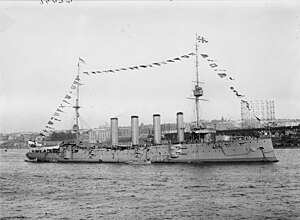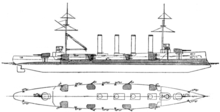HMS Drake (1901)
 Drake at anchor in New York Harbor in 1909
| |
| History | |
|---|---|
| Name | HMS Drake |
| Namesake | Sir Francis Drake |
| Builder | Pembroke Dock |
| Cost | approx. £800 000 |
| Laid down | 24 April 1899 |
| Launched | 5 March 1901 |
| Christened | Mrs. Lort Phillips |
| Completed | 9 January 1903 |
| Commissioned | 13 January 1903 |
| Fate | Sunk by U-79, 2 October 1917 |
| General characteristics | |
| Class and type | armoured cruiser |
| Displacement | 14,150 long tons (14,380 t) (normal) |
| Length | 533 ft 6 in (162.6 m) (o/a) |
| Beam | 71 ft 4 in (21.7 m) |
| Draught | 26 ft (7.9 m) |
| Installed power |
|
| Propulsion |
|
| Speed | 23 knots (43 km/h; 26 mph) |
| Complement | 900 |
| Armament |
|
| Armour | |
HMS Drake was the
She remained with the Grand Fleet until refitted in late 1915, when she was transferred to the
Design and description
The Drake-class ships were designed as faster and larger versions of the preceding

The main armament of the Drake class consisted of two
By February 1916, all of the lower casemates for her six-inch guns had been plated over and six of them had been remounted on the upper deck so they could be used in heavy weather. Several twelve-pounders had to be removed to make room for the six-inch guns.[6]
The ship's waterline armour belt had a maximum thickness of 6 inches and was closed off by 5-inch (127 mm) transverse bulkheads. The armour of the gun turrets and their barbettes was 6 inches thick while that of the casemates was 5 inches thick. The protective deck armour ranged in thickness from 1–2.5 inches (25–64 mm) and the conning tower was protected by 12 inches (305 mm) of armour.[2]
Construction and service
HMS Drake, named after the Elizabethan adventurer Sir
That fleet was merged into the Grand Fleet upon mobilization in mid-1914 and Drake became flagship of Rear Admiral William Grant, commander of the squadron. The squadron was briefly deployed at the beginning of the war to blockade the northern exit from the North Sea.[21] In October 1914, under the command of Aubrey Smith, the ship was used to carry Russian bullion worth eight million pounds to Britain; on arrival, Drake lay thirty miles off Archangel, and the gold was brought to her at night.[22] The ship was refitted in October 1915[23] and then transferred to the North America and West Indies Station for convoy escort duties.[12] She participated in the unsuccessful search in the West Indies for the German commerce raider SMS Möwe in December 1916.[24]
Drake was
Her wreck at 55°17.1084′N 06°12.5136′W / 55.2851400°N 6.2085600°W in Church Bay is a favourite site for divers because the wreck is only at a depth between 15–19 metres (49–62 ft) and generally has good visibility. Salvage of the wreck began in 1920 and continued for several years. On the night of 3 November 1962, the steam
Notes
- ^ "Cwt" is the abbreviation for hundredweight, 12 cwt referring to the weight of the gun.
Footnotes
- ^ Friedman 2012, pp. 243–52, 336
- ^ a b c Chesneau & Kolesnik, p. 69
- ^ a b Friedman 2012, p. 336
- ^ Friedman 2012, pp. 243, 260–61
- ^ Friedman 2012, pp. 250, 336
- ^ Friedman 2012, p. 247
- ^ Silverstone, p. 225
- ^ "The Launch of Four Warships". The Times. No. 36394. London. 5 March 1901. p. 8.
- ^ "Naval & Military intelligence". The Times. No. 36395. London. 6 March 1901. p. 10.
- ^ "Naval & Military intelligence". The Times. No. 36879. London. 22 September 1902. p. 8.
- ^ "Naval & Military intelligence". The Times. No. 36974. London. 10 January 1903. p. 6.
- ^ a b Friedman 2012, p. 244
- ^ Ross, p. 116
- ^ "Naval & Military intelligence". The Times. No. 36983. London. 21 January 1903. p. 8.
- ^ Heathcote, p. 129
- ^ Wikipedia, New York Times
- ^ Navy List 1908
- ^ The Navy List, January 1910. London: HMSO. 1910. p. 303.
- ^ The Navy List, August 1912. London: HMSO. 1912. p. 268.
- ^ The Navy List, July 1913. London: HMSO. 1913. p. 269b, 902.
- ^ Goldrick, p. 25
- ^ P. S. King, ed., The Russian Economist, vol. 1 (1920), p. 347: "The first shipment of gold from Russia to England, called for by the agreement between the British and Russian governments, and amounting to £8,000,000 sterling, took place in October 1914. The secrecy of this shipment was guarded by all possible precautions. The cruiser Drake and the military transport Mantois, upon reaching Archangel, were kept in the open sea at a distance of thirty miles from the land, and the gold was transhipped during the night from lighters."
- ^ Transcript
- ^ Newbolt, Vol. IV, pp. 181, 184
- ^ Helgason, Guðmundur. "Ships hit during WWI: HMS Drake". German and Austrian U-boats of World War I - Kaiserliche Marine - Uboat.net. Retrieved 28 February 2014.
- ^ Aspinall, pp. 554–59; Newbolt, Vol. V, p. 162; Wessex Archaeology, p. 18
- ^ Wessex Archaeology, pp. 3, 9–10
Bibliography
- Aspinwall, John Bridge, ed. (1921). Reports of Cases Relating to Maritime Law; Containing all the Decisions of the Courts of Law and Equity in the United Kingdom. Vol. XIV, New Series: From 1918 to 1920 (Reprint ed.). London: The Field Press.
- Chesneau, Roger & Kolesnik, Eugene M., eds. (1979). Conway's All the World's Fighting Ships 1860–1905. Greenwich: Conway Maritime Press. ISBN 0-8317-0302-4.
- Corbett, Julian (1997). Naval Operations. History of the Great War: Based on Official Documents. Vol. II (reprint of the 1929 second ed.). London and Nashville, Tennessee: Imperial War Museum in association with the Battery Press. ISBN 1-870423-74-7.
- Corbett, Julian (1997). Naval Operations. History of the Great War: Based on Official Documents. Vol. III (reprint of the 1940 second ed.). London and Nashville, Tennessee: Imperial War Museum in association with the Battery Press. ISBN 1-870423-50-X.
- Friedman, Norman (2012). British Cruisers of the Victorian Era. Barnsley, South Yorkshire, UK: Seaforth. ISBN 978-1-59114-068-9.
- Friedman, Norman (2011). Naval Weapons of World War One. Barnsley, South Yorkshire, UK: Seaforth. ISBN 978-1-84832-100-7.
- Goldrick, James (1984). The King's Ships Were at Sea: The War in the North Sea August 1914 – February 1915. Annapolis, Maryland: Naval Institute Press. ISBN 0-87021-334-2.
- Heathcote, Tony (2002). The British Admirals of the Fleet 1734 – 1995. Barnsley, UK: Leo Cooper. ISBN 0-85052-835-6.
- ISBN 0-224-04092-8.
- Newbolt, Henry (1996). Naval Operations. History of the Great War Based on Official Documents. Vol. IV (reprint of the 1928 ed.). Nashville, Tennessee: Battery Press. ISBN 0-89839-253-5.
- Newbolt, Henry (1996). Naval Operations. History of the Great War Based on Official Documents. Vol. V (reprint of the 1931 ed.). Nashville, Tennessee: Battery Press. ISBN 0-89839-255-1.
- Silverstone, Paul H. (1984). Directory of the World's Capital Ships. New York: Hippocrene Books. ISBN 0-88254-979-0.
- Ross, Stewart (1998). Admiral Sir Francis Bridgeman. Cambridge, UK: Baily's. ISBN 0-9523628-8-0.
- "Transcript: HMS DRAKE – June 1916 to August 1917, North America & West Indies Station, North Atlantic convoys". Royal Navy Log Books of the World War 1 Era. Naval-History.net. Retrieved 28 February 2014.
- Wessex Archaeology (December 2006). "HMS Drake, Church Bay, Rathlin Island: Undesignated Site Assessment.pdf" (PDF). Wessex Archaeology Online. Salisbury, Wiltshire, UK: Wessex Archaeology. Retrieved 1 March 2014.
Further reading
- Wilson, Ian (2011) HMS Drake: Rathlin Island Shipwreck. Rathlin Island: Rathlin Island Books. ISBN 978-0-9568942-0-5
